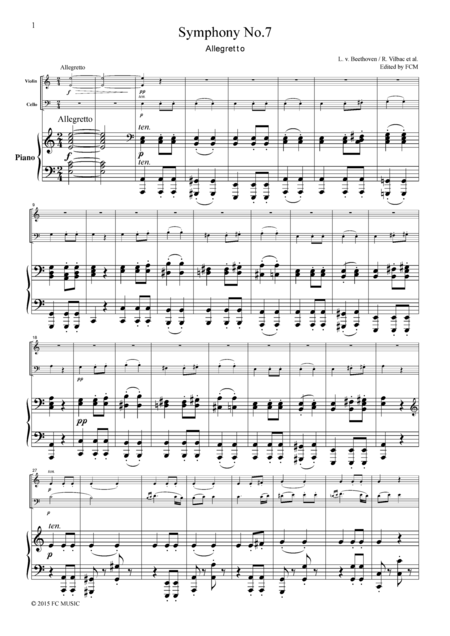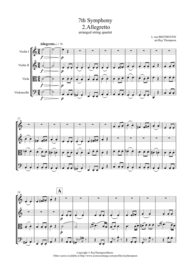
The finale carries to an extreme point, unimagined before Beethoven’s day and rarely reached since, a truly wild and swirling motion adumbrated in the first movement. The scherzo, sharply defined, moves like a superbly controlled machine. The finale is fast, too, but the sense of pace is quite different.

That scherzo’s contrasting trio, which may or may not be a quotation of a pilgrims’ hymn, is marked to go “very much less fast,” and ever since Toscanini took it strikingly faster than his colleagues (though still “very much less fast” than the extremely quick music of the movement’s outer sections), conductors, critics, and others have not ceased to argue about just what Beethoven meant-how much less is “very much less”? As in many of the big works of this period in his life, including the Pastoral Symphony, Beethoven makes the journey through the trio and the reprise of the scherzo twice, though with amusing variants. When we first hear it, it sets up the “walking” music of the lower strings when it reappears at the end, it is not so much a conclusion as a slightly eccentric preparation for the F major explosion of the scherzo. It is a chord of A minor, the home key, but with a “wrong” note-E instead of A-in the bass. A subtly unstable wind chord begins and ends the movement. The Allegretto that the first audiences-indeed audiences throughout the nineteenth century-liked so much is relaxed only by comparison with what comes before and after. The coda, as so often in Beethoven, is virtually another development, and Beethoven heaves it to a tremendous climax by making a crescendo across a tenfold repetition of an obsessive, harmonically off-balance bass. Having done so, he propels us with fierce energy and speed through one of those movements of his that are dominated by a single propulsive rhythm. Gradually, with a delicious feeling for suspense, Beethoven draws the Vivace from the last flickers of the introduction. The material-scales, and melodies that outline common chords-is of reckless simplicity. Obviously Beethoven’s aim is to draw attention not only to these shifts, but to these new harmonic areas, and in fact every one of the symphony’s journeys is foreshadowed here. The excursions to C and F are entered upon with startling bluntness. THE MUSIC A semi-slow introduction, the largest ever heard in any symphony until then and still one of the largest, defines great harmonic spaces, first A major, then C major (the gently lyric oboe tune), then F major (the same tune on the flute).

BEETHOVEN 7TH SYMPHONY 2ND ALLEGRETTO LIRIK SERIES
But the public liked the “companion piece” too, and the composer Louis Spohr, one of the violinists in the orchestra for the whole series of concerts, reports that the second movement was encored each time. To Beethoven’s annoyance, the critic of the Wiener Zeitung referred to the Seventh as having been composed “as a companion piece” to Wellington ’ s Victory. So great was the success that the entire program was repeated later in the month, again in January 1814, and once more in February. Between the Seventh Symphony and Wellington ’ s Victory, another gadget of Maelzel’s, a mechanical trumpeter, played marches written for the occasion by Dussek and Pleyel. The Panharmonicon was an invention of Johann Nepomuk Maelzel, whose most enduring contribution to music was the first dependable metronome. In the battle of Hanau, that October, Napoleon thrashed the mostly Bavarian army that attempted to block his retreat toward the southwest.) (At Vitoria, in northeast Spain, an army of English, Spanish, and Portuguese troops under the Duke of Wellington defeated the French on June 21, 1813. What caused the excitement was not, however, Opus 92, the new symphony, but Opus 91, Wellington ’ s Victory, or The Battle of Vitoria, originally written for a mechanical instrument called the Panharmonicon but presented even at this, its first performance, in the version for orchestra. The concert at which the work had its premiere-it was a benefit for Austrian and Bavarian soldiers wounded at the recent Battle of Hanau-was probably the most wildly successful of his career. THE BACKSTORY The Seventh Symphony is Beethoven’s last word for quite a few years on the subject of the big style he had been cultivating since the early 1800s. INSTRUMENTATION: 2 each of flutes, oboes, clarinets, bassoons, horns, and trumpets, with timpani and strings Ureli Corelli Hill conducted it at the Apollo Rooms, New York, at a concert of the Philharmonic Society

WORLD PREMIERE: December 8, 1813, at the University of Vienna BORN: Probably on Decem(his baptismal certificate is dated December 17, 1770).


 0 kommentar(er)
0 kommentar(er)
